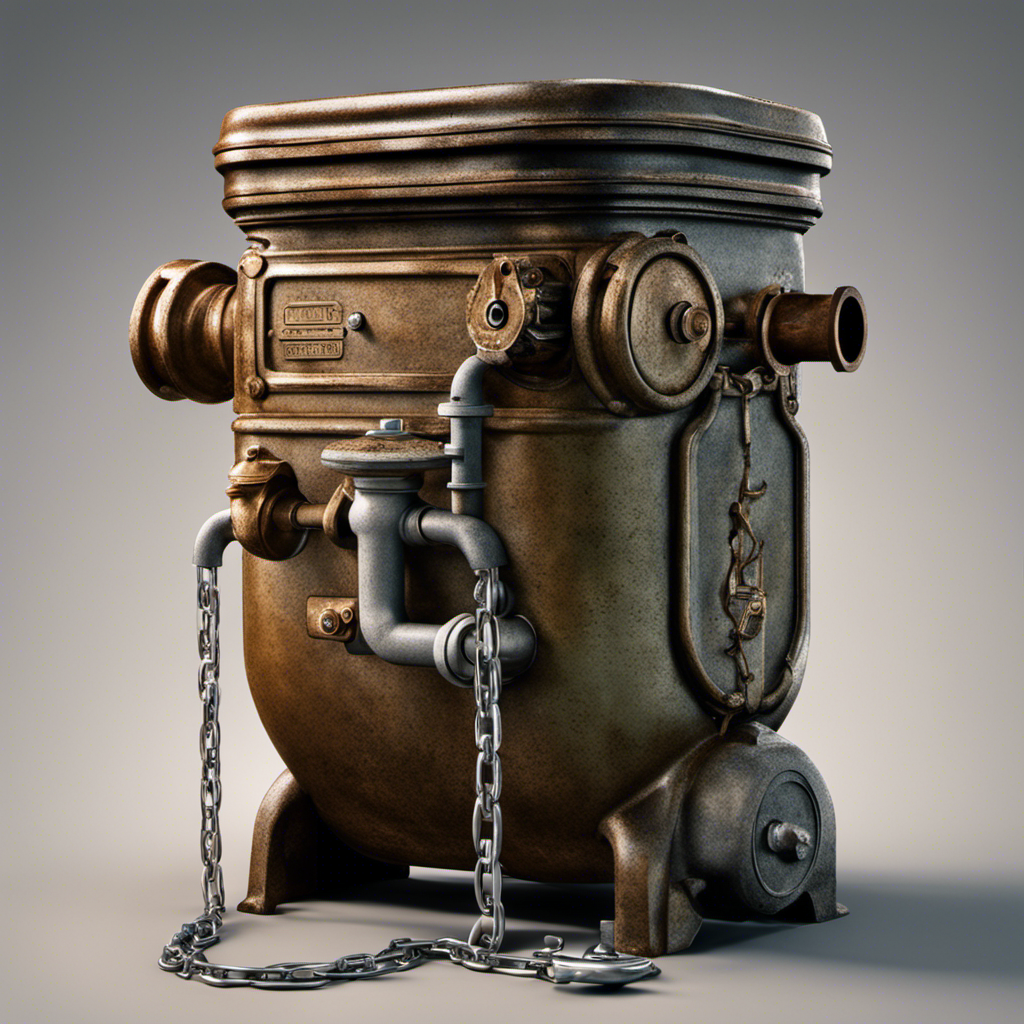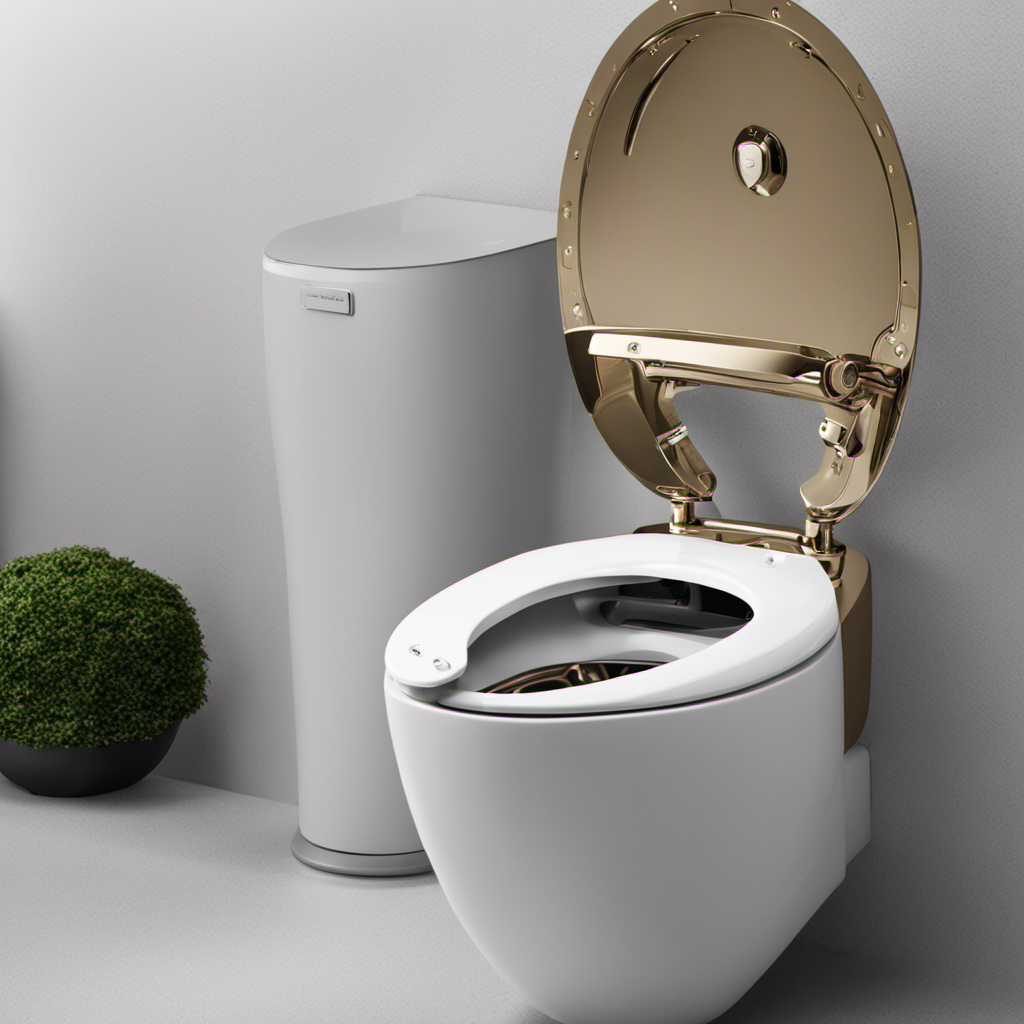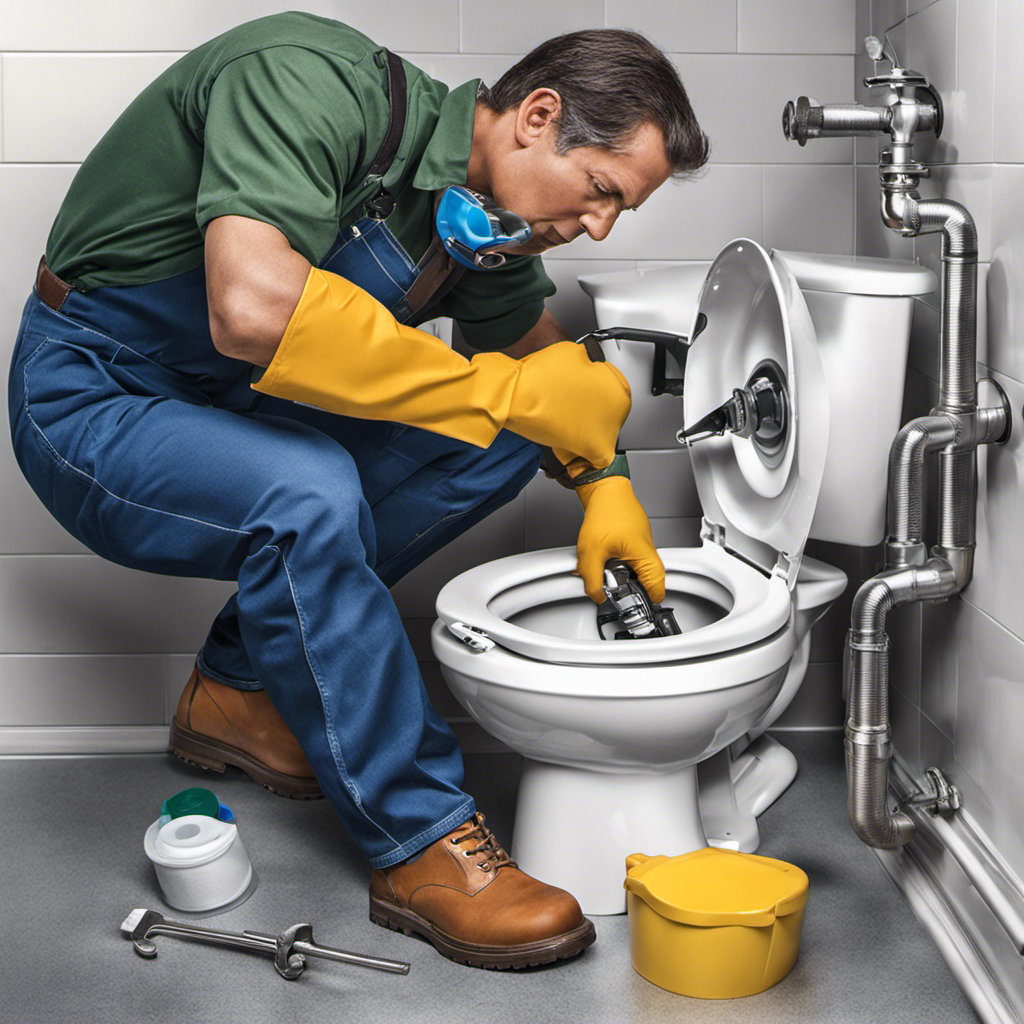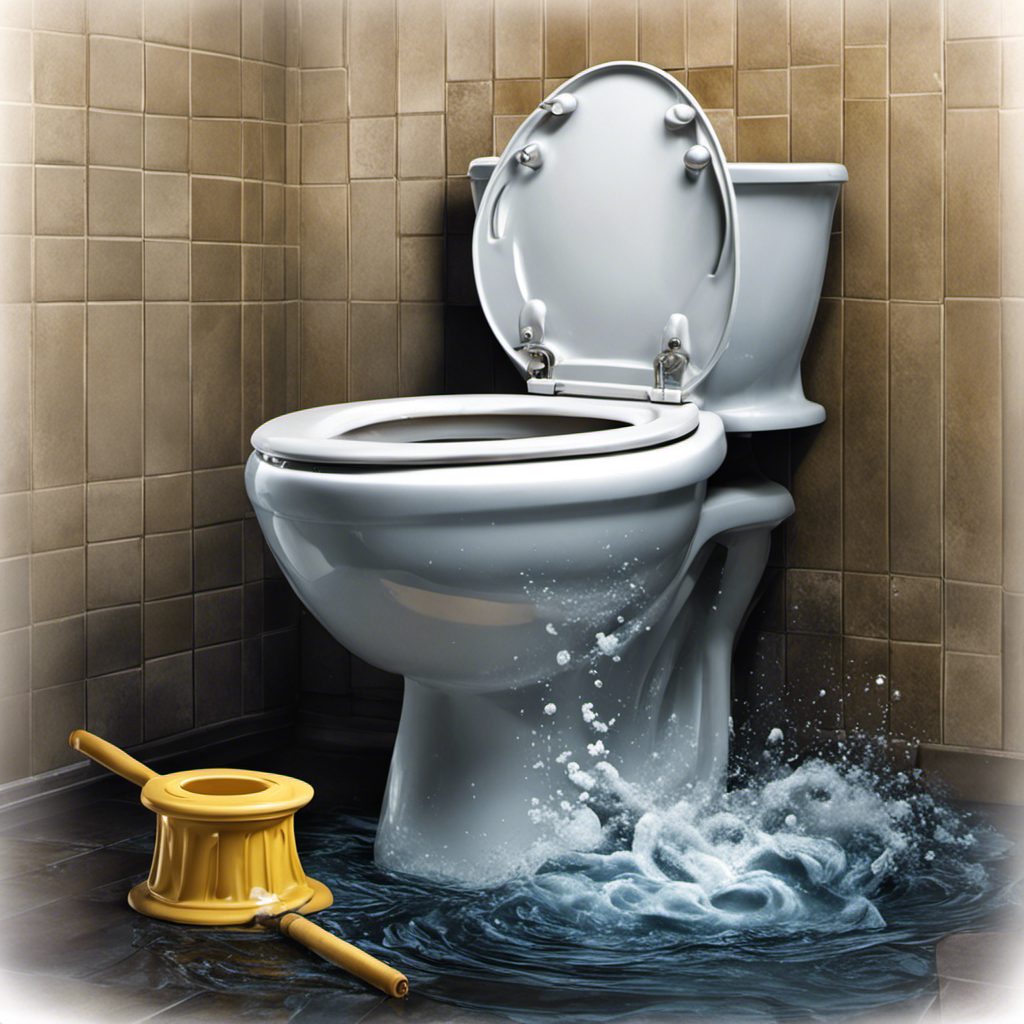As I sit in my bathroom, I can’t help but hear the incessant sound of water running. It’s a never-ending reminder that my toilet is once again refusing to cooperate.
But fear not, for I have embarked on a mission to uncover the reasons behind this frustrating problem and find a solution. In this article, I will explore the common causes of a running toilet, provide step-by-step instructions on how to fix it, and share some signs to look out for.
Together, let’s put an end to this endless symphony of running water.
Key Takeaways
- The common causes of a running toilet include faulty flapper valve, worn or damaged flapper valve, faulty fill valve, leaky flush valve, malfunctioning float, loose or damaged flush handle, improperly adjusted float, and water pressure issues.
- DIY solutions for a running toilet include adjusting the flapper chain, cleaning or replacing the flapper valve, checking and adjusting the float, tightening or replacing the flush handle, and checking and adjusting water pressure.
- It is important to conserve water as it conserves natural resources, reduces water bills, helps prevent water shortages, protects aquatic ecosystems, and contributes to a sustainable future.
- Regular toilet maintenance has several benefits such as preventing water wastage, ensuring efficient toilet operation, preventing debris buildup, extending the lifespan of toilet components, and saving money on repairs or replacements.
Common Causes of a Running Toilet
One common cause of a running toilet is a faulty flapper that needs to be replaced. The flapper is a small rubber piece that seals the water in the tank and prevents it from continuously flowing into the bowl. Over time, the flapper can become worn out or damaged, causing it to lose its ability to create a tight seal. This results in water continuously leaking into the bowl, leading to a running toilet.
Other possible causes of a running toilet include a faulty fill valve, a leaky flush valve, or a malfunctioning float. Identifying the specific cause of the problem is crucial for effective toilet repair.
In the following section, I will explain how to fix a running toilet and provide some DIY toilet fixes that can help resolve the issue.
How to Fix a Running Toilet
If you’re experiencing a running toilet, there are a few key points to consider.
First, a faulty flapper valve is a common culprit, causing water to continuously leak into the bowl.
Second, adjusting the water level in the tank can help prevent overflow and reduce unnecessary water usage.
Lastly, if all else fails, it may be necessary to replace the fill valve to ensure proper functioning of the toilet.
Faulty Flapper Valve
To fix the issue with your toilet constantly running, check if the flapper valve is faulty.
The flapper valve is a key component of the toilet tank, responsible for controlling the water flow. If it is damaged or worn out, it can cause water to continuously flow into the toilet bowl, resulting in a running toilet.
To determine if the flapper valve needs to be replaced or repaired, start by inspecting it for any signs of damage or deterioration. If you notice cracks, warping, or discoloration, it is likely that the flapper valve needs to be replaced.
However, if it appears to be in good condition, you may be able to fix the issue by cleaning or adjusting the flapper valve.
Adjusting Water Level
Inspecting the water level in the toilet tank can help determine if it needs to be adjusted. To ensure proper functionality and prevent water wastage, it is essential to maintain the correct water level in the tank. Here are some steps to adjust the water level:
- Locate the water level adjustment screw or valve on the fill valve.
- Turn the adjustment screw or valve clockwise to decrease the water level or counterclockwise to increase it.
- Flush the toilet and observe the water level.
- Repeat the adjustment if necessary until the desired water level is achieved.
By adjusting the water level, you can prevent issues like constant running or overflowing toilets.
Regular toilet tank maintenance, including adjusting the water pressure, is crucial to keeping your toilet in optimal condition and conserving water.
Replace Fill Valve
Replacing the fill valve is necessary to fix issues with the toilet’s water level and prevent water wastage. The fill valve is responsible for refilling the tank after each flush, and if it is not functioning properly, it can lead to a constantly running toilet. This not only wastes water but can also result in higher water bills. To replace the fill valve, you will need a few tools such as an adjustable wrench and a replacement fill valve kit. Here is a simple step-by-step guide:
| Steps | Tools |
|---|---|
| 1. Shut off the water supply to the toilet. | Adjustable wrench |
| 2. Flush the toilet to drain the water from the tank. | Replacement fill valve kit |
| 3. Disconnect the water supply line from the fill valve. | |
| 4. Remove the old fill valve by unscrewing it from the tank. | |
| 5. Install the new fill valve and tighten the connections. | |
| 6. Reconnect the water supply line. | |
| 7. Turn on the water supply and check for any leaks. |
Signs of a Running Toilet
I’ve noticed some concerning signs lately. My water bill has been steadily increasing and there’s a continuous sound of water running in my house.
These issues often go hand in hand and can indicate a running toilet, which can be a major source of water waste.
In this discussion, I will explore the possible causes of a running toilet and provide solutions to help address this problem.
Water Bill Increasing
If your water bill is increasing, it’s possible that your running toilet is the culprit. A running toilet can waste a significant amount of water, leading to higher bills and a negative impact on water conservation efforts.
To detect if your toilet is running, you can try the following:
- Add food coloring to the toilet tank and wait for a few minutes. If the water in the bowl changes color without flushing, there is a leak.
- Listen for continuous water sounds, as this indicates that water is constantly flowing into the toilet tank.
- Check the toilet flapper, as a worn or misaligned flapper can cause a constant flow of water.
By detecting and fixing leaks promptly, you can save water and reduce your water bills.
Now, let’s explore the next sign of a running toilet: the continuous water sound.
Continuous Water Sound?
The continuous water sound coming from your toilet may indicate a running toilet. This is a common issue that can lead to unnecessary water wastage and higher water bills.
To address this problem, it is important to perform regular toilet maintenance to ensure optimal performance and water conservation. Start by checking the flapper valve, which is the rubber seal at the bottom of the tank. If it is worn out or not sealing properly, it may need to be replaced.
Another potential cause could be a faulty fill valve or float, which may need adjustment or replacement. By addressing these issues promptly, you can conserve water and avoid unnecessary expenses.
Now, let’s move on to troubleshooting a running toilet and finding the right solution.
Troubleshooting a Running Toilet
To troubleshoot a running toilet, check the flapper valve for any signs of wear or damage. The flapper valve is responsible for controlling the flow of water from the tank to the bowl. If it’s not sealing properly, water will continuously leak into the bowl, causing the toilet to run.
Here are a few steps you can take to troubleshoot the issue:
- Inspect the flapper valve for any cracks, tears, or misalignment.
- Clean the flapper valve and the area around it to remove any debris or mineral buildup.
- Adjust the chain length connecting the flapper valve to the flush lever, ensuring it has enough slack to allow the valve to fully close.
By following these troubleshooting steps, you can easily identify and fix the problem causing your toilet to run.
Now, let’s move on to preventing a toilet from running altogether.
Preventing a Toilet From Running
One simple way to prevent a running toilet is by regularly checking and maintaining the flapper valve. The flapper valve is a crucial component of the toilet’s flushing mechanism, and if it becomes worn or damaged, it can cause water to continuously leak into the toilet bowl, resulting in a running toilet. By inspecting the flapper valve for any signs of wear or damage, such as cracks or tears, and replacing it if necessary, you can ensure that your toilet operates efficiently and does not waste water. Additionally, it is important to regularly clean the flapper valve and the surrounding area to prevent any debris or mineral buildup that could interfere with its proper functioning. By taking these simple steps, you can contribute to water conservation efforts while also avoiding the annoyance and inconvenience of a running toilet.
| Maintenance Tips | Benefits |
|---|---|
| Regularly check and maintain the flapper valve | Prevents water wastage |
| Inspect for wear or damage and replace if necessary | Ensures efficient toilet operation |
| Clean the flapper valve and surrounding area regularly | Prevents debris buildup and ensures proper functioning |
Professional Help for a Running Toilet
After trying DIY solutions to prevent my toilet from running, I realized that I may need professional advice to fix the issue. Sometimes, the problem goes beyond what can be fixed with simple at-home remedies. Here are a few reasons why seeking professional help for a running toilet can be beneficial:
-
Expertise: Professionals have the knowledge and experience to diagnose the root cause of the problem accurately.
-
Time-saving: Instead of spending hours trying different solutions, professionals can quickly identify and fix the issue.
-
Long-term solutions: Professionals can provide lasting solutions to ensure that the toilet doesn’t continue to run in the future.
While DIY solutions may work for minor issues, it is always wise to consult professionals for more complex problems. They can offer the expertise needed to resolve the problem effectively and efficiently.
Conclusion
In conclusion, dealing with a running toilet can be quite a hassle. However, by understanding the common causes and following the steps to fix it, you can put an end to this annoying issue.
Remember to look out for signs of a running toilet and troubleshoot any problems that arise. By practicing preventative measures, you can ensure that your toilet stays in proper working condition.
And if all else fails, don’t hesitate to seek professional help. With these solutions at hand, you can bid farewell to the never-ending sound of a running toilet.










